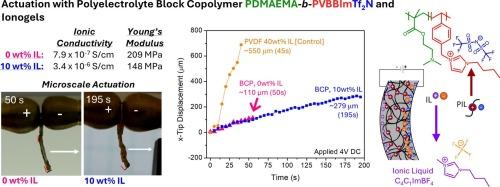Novel electroactive polymer actuators using all-polyelectrolyte poly(ionic liquid) ionogels
IF 6.3
2区 化学
Q1 POLYMER SCIENCE
引用次数: 0
Abstract
Poly(ionic liquid)-based ionogels are excellent all-poly(electrolyte) candidates for electroactive actuation applications, but investigation of their actuation behavior and ionogel properties has largely been limited to styrenic block copolymers. In this work, ionogels were prepared from a novel poly(ionic liquid) (PIL) block copolymer, poly[(2-dimethyl amino)ethyl methacrylate)]-block-poly[4-vinylbenzyl-3-butyl imidazolium bis(trifluoromethylsulfonyl)imide] (PDMAEMA-b-PVBBImTf2N) combined with an ionic liquid, 1-butyl-3-methyl imidazolium tetrafluoroborate (C4C1ImBF4), at weight percentages between 0 to 40 wt%. Under a low applied voltage (4 V DC) microscale actuation was achieved for films prepared from the neat PDMAEMA-b-PVBBImTf2N block copolymer, as well as its corresponding 10 wt% ionogel; this result critically expands the PIL block copolymer chemistries available for electroactive actuator applications. Thermal, ionic conductivity, morphology, and mechanical modulus properties of the PDMAEMA-b-PVBBImTf2N ionogels were also assessed to evaluate their potential for electrochemical applications. Addition of the ionic liquid to form an ionogel significantly increased the thermal stability of the PDMAEMA polymer block and successfully plasticized the PDMAEMA-b-PVBBImTf2N block copolymer ionogel, as evidenced by decreases in the glass transition temperature and significant enhancement of the ionic conductivity from ∼10−7 S/cm in the neat polymers to ∼10−4 S/cm in the 40 wt% ionogels. AFM force curve analyses using a Derjaguin-Muller-Toporov (DMT) model showed a reduction of Young’s modulus for the block copolymer matrix as a function of increasing ionic liquid content, and the PDMAEMA-rich phase exhibits a higher modulus, which serves to mechanically reinforce the PIL matrix. In combination the material properties and electrical responsiveness of these novel all-polyelectrolyte PDMAEMA-b-PVBBImTf2N block copolymer ionogels show excellent potential for micro-scale electroactive actuation and other electrochemical applications.

采用全聚电解质聚离子液体离子凝胶的新型电活性聚合物致动器
基于聚(离子液体)的离子凝胶是电活性驱动应用的优秀的全聚(电解质)候选者,但对其驱动行为和离子凝胶性质的研究在很大程度上仅限于苯乙烯嵌段共聚物。在这项工作中,将一种新型聚(离子液体)(PIL)嵌段共聚物聚[(2-二甲基氨基)甲基丙烯酸乙酯]-嵌段聚[4-乙烯基苄基-3-丁基咪唑二(三氟甲基磺酰基)亚胺](pdmama -b- pvbbimtf2n)与离子液体1-丁基-3-甲基咪唑四氟硼酸盐(C4C1ImBF4)结合制备了离子凝胶,重量百分比在0到40 wt%之间。在低电压(4v DC)下,由整齐的PDMAEMA-b-PVBBImTf2N嵌段共聚物及其相应的10wt %离子凝胶制备的薄膜实现了微尺度驱动;这一结果极大地扩展了可用于电活性执行器应用的PIL嵌段共聚物化学物质。还对PDMAEMA-b-PVBBImTf2N离子凝胶的热、离子电导率、形貌和力学模量性能进行了评估,以评估其电化学应用潜力。加入离子液体形成的离子凝胶显著提高了PDMAEMA聚合物嵌段的热稳定性,并成功地塑化了PDMAEMA-b- pvbbimtf2n嵌段共聚物离子凝胶,证明了玻璃化转变温度的降低和离子电导率的显著提高,从整齐聚合物的~ 10−7 S/cm到40 wt%离子凝胶的~ 10−4 S/cm。使用derjaguin - muler - toporov (DMT)模型的AFM力曲线分析表明,嵌段共聚物基体的杨氏模量随着离子液体含量的增加而降低,而富pdmaema相的模量更高,这有助于机械强化PIL基体。结合这些新型全聚电解质PDMAEMA-b-PVBBImTf2N嵌段共聚物离子凝胶的材料特性和电响应性,显示出微尺度电活性驱动和其他电化学应用的良好潜力。
本文章由计算机程序翻译,如有差异,请以英文原文为准。
求助全文
约1分钟内获得全文
求助全文
来源期刊

European Polymer Journal
化学-高分子科学
CiteScore
9.90
自引率
10.00%
发文量
691
审稿时长
23 days
期刊介绍:
European Polymer Journal is dedicated to publishing work on fundamental and applied polymer chemistry and macromolecular materials. The journal covers all aspects of polymer synthesis, including polymerization mechanisms and chemical functional transformations, with a focus on novel polymers and the relationships between molecular structure and polymer properties. In addition, we welcome submissions on bio-based or renewable polymers, stimuli-responsive systems and polymer bio-hybrids. European Polymer Journal also publishes research on the biomedical application of polymers, including drug delivery and regenerative medicine. The main scope is covered but not limited to the following core research areas:
Polymer synthesis and functionalization
• Novel synthetic routes for polymerization, functional modification, controlled/living polymerization and precision polymers.
Stimuli-responsive polymers
• Including shape memory and self-healing polymers.
Supramolecular polymers and self-assembly
• Molecular recognition and higher order polymer structures.
Renewable and sustainable polymers
• Bio-based, biodegradable and anti-microbial polymers and polymeric bio-nanocomposites.
Polymers at interfaces and surfaces
• Chemistry and engineering of surfaces with biological relevance, including patterning, antifouling polymers and polymers for membrane applications.
Biomedical applications and nanomedicine
• Polymers for regenerative medicine, drug delivery molecular release and gene therapy
The scope of European Polymer Journal no longer includes Polymer Physics.
 求助内容:
求助内容: 应助结果提醒方式:
应助结果提醒方式:


